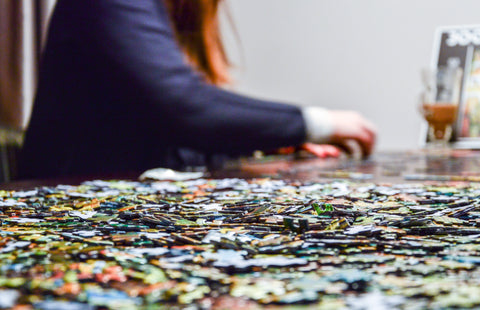Tips & Tricks for Completing a 1,000 Piece Puzzle
Many people enjoy the feeling of jumping into a lower-count puzzle, solving problems and connecting pieces as they go. However, using this same method on a higher-count puzzle will only bring frustration. We enjoy challenges, not seemingly-impossible tasks.
1,000 piece puzzles represent a wall that piece-by-piece instinct cannot scale. Rather than tackling the puzzle in one go, breaking it out into a series of manageable tasks will keep your brain engaged and allow for constant progress. Laid out below is a step-by-step guide to completing a 1,000 piece puzzle that, once mastered, you can apply to a puzzle of any size!
Where do I Start?
The Workspace
Before we take out the pieces, you need to set up a workspace for a puzzle of this size. Note the dimensions of the puzzle you're creating and clear a flat surface where you won't be disturbed. You don’t want to start a puzzle and realize halfway that you need to move your station.
Give yourself enough time to finish! A 1,000 piece puzzle will often take longer than expected.
The Setup
Open your puzzle and turn every piece picture-side up. This may seem tedious, but it tees up every following step and will reduce the overall time your puzzle will take.
Again, don’t jump into fitting pieces together — the probability of finding matching pieces is small. Additionally, don’t immediately start from a corner or an edge. The goal of our 1,000 Piece Puzzling Strategy is to always be maximizing the number of clues and minimizing the pool of options.
Sort your pieces by color and pattern. These are the most easily-distinguished features and they offer a way to break the puzzle into a series of manageable sub-tasks. Also, set aside corner and edge pieces.
Optional tip: Divide your piles into smaller collections of pieces based on their number of tabs and blanks. With those defined, you can further minimize the number of options for every connection as you go.
Let the Puzzling Begin
Build the Framework
 Many people like to create the border of their puzzle first. This allows you to better define your workspace and visualize the scale of each section.
Many people like to create the border of their puzzle first. This allows you to better define your workspace and visualize the scale of each section.
Then, begin working through your segmented piles. Start with pieces that have high-contrast features that you can more easily correlate. Examples of this can include:
- Faces and groups of people
- Windows, doors, and chimneys
- Printed signs or text
- The skyline and outlines of buildings
Some of the more featureless sections of the puzzle — such as a sky, lake or field — can be left to do later.
Scale the Wall
When you have a few small clusters created from high-contrast pieces, begin extending them outwards. If you're a visual learner, it can help to place your clusters where they would be in the puzzle framework. You can also take this time to connect your clusters to the border you created. If you further separated your pieces by tabs and blanks in The Setup, this stage will go faster.
This can be the most difficult or frustrating part of the puzzling process, as the number of clues has decreased. More than anything, don't give up! When you're tired or bored, take a break. Puzzling should be challenging, but not stressful. A fresh perspective on another day may help you find something you missed.
Completion
Fill in all the remaining gaps and finish your puzzle! Take some time to enjoy your work — you put a lot of effort and energy into this process, and your strategies paid off.
When you're done, you can either glue and frame your puzzle or scramble the pieces and offer someone else a chance! If you're up for it, try another 1,000 piece puzzle or even a more difficult one. As with any sport or occupation, you'll only get better with practice.
Share this post
- Tags: 1000 piece puzzles, puzzling tips
